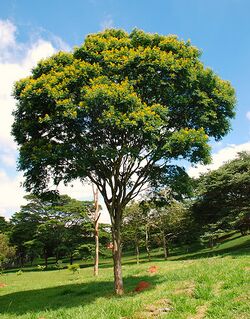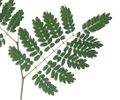Biology:Libidibia ferrea
| Brazilian ironwood | |
|---|---|

| |
| Scientific classification | |
| Kingdom: | Plantae |
| Clade: | Tracheophytes |
| Clade: | Angiosperms |
| Clade: | Eudicots |
| Clade: | Rosids |
| Order: | Fabales |
| Family: | Fabaceae |
| Subfamily: | Caesalpinioideae |
| Genus: | Libidibia |
| Species: | L. ferrea
|
| Binomial name | |
| Libidibia ferrea (Mart. ex Tul.) L.P.Queiroz[2]
| |
| Synonyms[2] | |
| |
Libidibia ferrea, formerly Caesalpinia ferrea,[3][4] and commonly known as pau ferro, Jucá, Brazilian ironwood, morado, or leopard tree,[5] is a tree found in Brazil and Bolivia.
Pau ferro can also refer to several other species: Platymiscium floribundum var. nitens, Peltogyne paniculata, or Machaerium scleroxylon. Among guitar builders, the latter is probably meant.
Wood
Most species of Caesalpinia s.l. have poorly defined growth rings, with isolated vessels arranged in radial multiples. Pitting between vessels is alternate and covered, and fibres are generally not divided by a septum. The axial (i.e., longitudinal) parenchyma varies from a winged shape to confluent, and is irregularly storied (i.e., layered), while the rays (perpendicular to growth rings) are of variable height and generally comprise a single or double cell width.[4] Libidibia in particular has layered longitudinal parenchyma and narrow homocellular (i.e., of uniform type) rays without crystals in the ray cells.[4]
Uses
Its wood has a similar feel and similar tonal attributes to rosewood, but is near 1000 points softer on the janka hardness scale on average or more than all of the commonly traded species of rosewood except for Sisso and Amazonian rosewood. It also ranks lower in density of 5-10lbs per cubic foot compared to common rosewoods (roughly 54lbs/cf compared to 60-66lbs/cf), though it does have a negligibly higher crushing strength and modulus of rupture than a few species of rosewood. Pau Ferro is lighter colored having more tans and light browns contrasting darker areas of its figure.[6] The wood may also be used for flooring, fancy furniture, and handgun grips. It is also known by the names morado, palo santo, caviuna, Brazilian ironwood, and Bolivian rosewood, though it is not actually rosewood.
In guitar making, pau ferro is mainly used for fingerboards and bridges. Some luthiers also use it for the back and sides of acoustic guitars. The Brazilian guitar company Giannini uses laminated pau ferro in many of their classical guitars.[7]
Following the expansion of CITES regulations to restrict trade on all species of rosewood in 2017, Fender began using pau ferro on models which had previously featured rosewood fretboards. Although the restrictions were lifted in 2019, pau ferro fretboards remained in place across much of the manufacturer's product range, in particular on Mexican-made instruments.[8] The Stevie Ray Vaughan Signature Fender Stratocaster was one of the company's first instruments to feature a pau ferro fingerboard.
Utilization as a natural product
In the Amazon region, Libidibia ferrea has extensive use in popular medicine, known mainly as "jucá", being indicated to treat several health conditions, in the form of teas and infusions to treat bronchopulmonary conditions, diabetes, rheumatism, cancer, disorders gastrointestinal, diarrhea; in addition to topical treatment of wounds and bruises.[9] Although it has many indications of use for treating different diseases, jucá pods are mainly used by the Amazon people for the treatment of wounds, usually in alcoholic solution, and scientific studies have already shown the healing activity of different parts of Jucá in different animal species, such as goats,[10] rats [11] and donkeys.[12] A recent study that compared different formulations and concentrations of the ethanolic extract from Jucá (Libidibia ferrea) pods showed that the natural products showed excellent healing activity in open dermal wounds in dogs, and also had moderate in vitro antimicrobial activity.[13]
Allergy information
Pau ferro, used as a rosewood substitute, is a strong sensitizer capable of causing acute outbreaks of allergic and irritant dermatitis in workers not previously exposed to it. This, however, has not prevented furniture factories from using the product. Apparently, most workers develop tolerance to the wood.[citation needed] The allergen is (R)-3,4-dimethoxydalbergion, a strong skin sensitizer.[14]
References
- ↑ Botanic Gardens Conservation International (BGCI); IUCN SSC Global Tree Specialist Group (2019). "Libidibia ferrea". IUCN Red List of Threatened Species 2019: e.T62021470A149201449. doi:10.2305/IUCN.UK.2019-2.RLTS.T62021470A149201449.en. https://www.iucnredlist.org/species/62021470/149201449. Retrieved 12 December 2022.
- ↑ 2.0 2.1 "Libidibia ferrea (Mart. ex Tul.) L.P.Queiroz". Plants of the World Online. Royal Botanic Gardens, Kew. https://powo.science.kew.org/taxon/urn:lsid:ipni.org:names:77100755-1.
- ↑ Gagnon, E.; Lewis, G.P.; Solange Sotuyo, J.; Hughes, C.E.; Bruneau, A. (November 2013). "A molecular phylogeny of Caesalpinia sensu lato: Increased sampling reveals new insights and more genera than expected". South African Journal of Botany 89: 111–127. doi:10.1016/j.sajb.2013.07.027.
- ↑ 4.0 4.1 4.2 Gasson, Peter; Warner, Kate; Lewis, Gwilym (2009). "Wood Anatomy of Caesalpinia S.S., Coulteria, Erythrostemon, Guilandina, Libidibia, Mezoneuron, Poincianella, Pomaria and Tara (Leguminosae, Caesalpinioideae, Caesalpinieae)". IAWA Journal 30 (3): 247–276. doi:10.1163/22941932-90000218.
- ↑ {{citation | mode = cs1 | title = Caesalpinia ferrea Mart. ex Tul. | work = Germplasm Resources Information Network (GRIN) | url = https://npgsweb.ars-grin.gov/gringlobal/taxonomydetail.aspx?8289 | publisher = [[Organization:Agricultural Research ServAgricultural Research Service (ARS), United States Department of Agriculture (USDA) | access-date = 12 February 2012 }}
- ↑ "? PAU FERRO Wood Guide: Indian Rosewood Alternative 2022". 21 May 2019. https://www.commercialforestproducts.com/pau-ferro-rosewood/.
- ↑ classical giannini guitar
- ↑ "Fender CITES Changes - Rosewood vs. Pau Ferro Fretboards". https://www.andertons.co.uk/fender-cites-rosewood-pau-ferro. Retrieved August 16, 2018.
- ↑ Vásquez, Silvia Patricia Flores; Mendonça, Maria Silvia de; Noda, Sandra do Nascimento (December 2014). "Etnobotânica de plantas medicinais em comunidades ribeirinhas do Município de Manacapuru, Amazonas, Brasil". Acta Amazonica 44 (4): 457–472. doi:10.1590/1809-4392201400423. ISSN 0044-5967.
- ↑ Oliveira, A.F.; Batista, J.S.; Paiva, E.S.; Silva, A.E.; Farias, Y.J.M.D.; Damasceno, C.A.R.; Brito, P.D.; Queiroz, S.A.C. et al. (September 2010). "Avaliação da atividade cicatrizante do jucá (Caesalpinia ferrea Mart. ex Tul. var. ferrea) em lesões cutâneas de caprinos". Revista Brasileira de Plantas Medicinais 12 (3): 302–310. doi:10.1590/S1516-05722010000300007. ISSN 1516-0572.
- ↑ Kobayashi, Yuri Teiichi da Silva; Almeida, Vívian Tavares de; Bandeira, Talita; Alcântara, Bianca Nascimento de; Silva, Andressa Santa Brígida da; Barbosa, Wagner Luiz Ramos; Silva, Paula Barbosa da; Monteiro, Maria Vivina Barros et al. (2015-04-13). "Avaliação fitoquímica e potencial cicatrizante do extrato etanólico dos frutos de Jucá (Libidibia ferrea) em ratos Wistar". Brazilian Journal of Veterinary Research and Animal Science 52 (1): 34. doi:10.11606/issn.1678-4456.v52i1p34-40. ISSN 1678-4456. http://www.revistas.usp.br/bjvras/article/view/61477.
- ↑ Oliveira, Ilanna Vanessa Pristo de Medeiros; Dias, Regina Valéria da Cunha; Calado, Eraldo; Lucena, Rivaldo; Costa, Antonio Leandro; Sakamoto, sidney Miyoshi; Pimentel, Muriel Magda Lustosa (2014-07-07). "AVALIAÇÃO CICATRICIAL MACROSCÓPICA DA VAGEM E DA CASCA DO JUCÁ (CAESALPINIA FERREA MART. EX TUL. VAR. FERREA) EM LESÕES CUTÂNEAS EM ASININOS (EQUUS ASINUS)" (in pt). Acta Veterinaria Brasilica 8 (2): 129–135. doi:10.21708/avb.2014.8.2.3578. ISSN 1981-5484. https://periodicos.ufersa.edu.br/index.php/acta/article/view/3578.
- ↑ Américo, Ádria Vanessa Linhares dos Santos; Nunes, Kariane Mendes; Assis, Francisco Flávio Vieira de; Dias, Salatiel Ribeiro; Passos, Carla Tatiane Seixas; Morini, Adriana Caroprezo; Araújo, Junior Avelino de; Castro, Kelly Christina Ferreira et al. (2020-06-12). "Efficacy of Phytopharmaceuticals From the Amazonian Plant Libidibia ferrea for Wound Healing in Dogs". Frontiers in Veterinary Science 7: 244. doi:10.3389/fvets.2020.00244. ISSN 2297-1769. PMID 32656247.
- ↑ Department of Dermatology, Gentofte Hospital, Hellerup, Denmark
Wikidata ☰ {{{from}}} entry
 |







